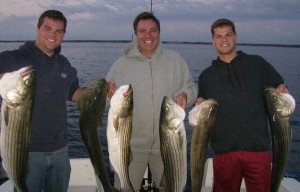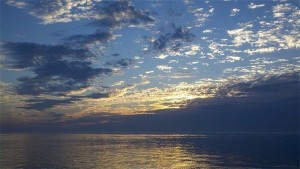One of the most daunting tasks, especially in our neck of the woods, is locating quality fish. It does not matter what species of fish is targeted, the ability to consistently find fish on each fishing trip is half the battle, and is the most important ingredient to a successful season.
Locating fish is very much like finding a needle in a haystack. However it is possible to consistently locate quality fishing, no matter the time of year, weather conditions or the presence of bait, as long as a sound strategy is employed.
And in this day an age, consistently locating great fishing relies heavily upon the use of electronics.
Finding a Place to Start
We all love those rare days when diving birds and breaking fish lead the way to great fishing. Or those exceptional moments when the fishing report we read in yesterday’s newspaper rings true.
The fact is that on most trips we do not have these luxuries. More often than not we are greeted by miles of seemingly lifeless water with no clues as to where the bite is best. Which poses the question, amidst all this open water, where do we start?
Utilizing the most up to date information possible is a smart way to develop a starting point.

Let’s say the only information we have is that last weekend a few nice bass were caught in 60 feet of water somewhere in the area you are fishing. While we are not given any detailed information by this report, the tidbit of information we are given (60 feet of water) is crucially important considering the vastness of the ocean.
Sixty feet of water will be our starting point.
Beginning the Search
Cruising out to a depth of 60 feet and immediately putting baits in the water is not a smart decision. The odds that fish will be holding in the first spot we try, even if it is a well known hot spot, are extremely slim.
It is also a waste of precious time to troll around for hours in 60 feet of water, hoping and praying to stumble across a fish or two. On the other hand, we can maximize our time and increase efficiency by taking a more proactive approach to finding fish using our electronics.
All that is needed is a reliable color sonar unit. Systems worth thousands of dollars are nice, however a color unit purchased for a few hundred bills will work just fine.
The second step to consistently finding fish is to determine what direction to begin the search. Say for example you reach a depth of 60 feet and know from experience that you have done well to the west. In this case it makes the most sense to begin our search by heading in a westerly direction.
Keeping a close eye on the sonar, we’ll cruise west at a reasonable speed-one that will allow us to clearly see fish marks on the sonar, while also allowing us to cover plenty of water. For most units, a speed of around eight miles per hour works fine for marking individual fish.
Because the ocean is vast, and for the most part, devoid of any fish holding structure, we commonly may go miles without marking a single fish on the sonar. This is great news because we have just eliminated miles of water that we may of wasted hours trolling through.
When to Start Fishing
On some trips it may only take a few minutes to mark a bass or tuna on the sonar, and on other trips it may take multiple hours. However it is important to not underestimate the importance of even just one single mark on the sonar.
If you see a definitive bass or tuna mark on the sonar, odds are that you have found one of but hundreds of fish in the area. Striped bass are especially prone to hang out in large schools. During 2010 we found on various instances, schools of bass close to a mile in length.
More often than not that one mark on the screen, is but one of many fish holding in the immediate area.

Now is the time to put lines in the water and begin fishing. And if after fifteen or twenty minutes, there are no takes or additional fish marked on the sonar, it is time to resume the search.
It is often possible to locate a school of say 20-40 pound stripers, and follow them for miles. However it is easy to lose the school if too much time is spent fishing in one area, and not enough time is spent using sonar to remain on top of the bass.
Breaking Free from Traditional Methods
A lot of folks tend to get caught up on hammering the GPS coordinates from a successful past trip, or gravitating to well known hot spots or fleets of other boats. Often times, lines go in the water despite no evidence of fish on the sonar.
The reality is that fish are almost constantly on the move, and often move quickly. In wide open areas without structure and significant current, spending more time actively on the move, and less time with lines in the water, will increase the odds of locating an area holding fish.

